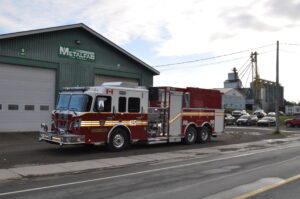
What Is a Clean Cab Concept?
It might be surprising to learn that one of the leading causes of death for a firefighter is cancer. Firefighters face increased carcinogen exposure when inhaling airborne chemicals at fire scenes and settling on firefighters’ gear. According to a study by the University of the Fraser Valley in British Columbia, cancer caused 90% of firefighter deaths in 2018, up from 85% in 2015.
Why does this happen? Contaminated gear is often placed into the cabs after a fire, and the interior of the apparatus cab is rarely decontaminated. The contaminated particles attach to their gear and transfer to the apparatus. Once the trucks return to the station, contaminants adhere to the walls and other equipment, resulting in the off-gassing of contaminants. Exposure is not only a risk to the firefighter but to anyone who may visit the fire station, especially if the contaminants are not completely removed before the end of a shift.
Fortunately, there are steps firehouse crews can take to reduce risk. The industry has many choices for treating surfaces and the interior environment. There are several systems available to take care of specific issues:
- Systems that pull contaminated/dirty air into the device, scrub particulates or contaminants from the air, and then return clean/disinfected air into the cab.
- Systems that use technology to actively push disinfection out into the atmosphere, attacking contaminants in the air and on surfaces.
- Systems that use a disinfecting light source to attack contaminants in the air and on surfaces inside the cab directly.
You can also choose your technology, which includes ultraviolet lighting, UV-C lights, LED-based UV-C units, ionizers, photohydroionization, and combination systems with UV-C and HEPA air filtration.
If you’re unsure which resource is appropriate for your station, these key factors should be considered:
- Will the operation of the system require user interaction regularly?
- Is the technology treating both the air and surfaces?
- If the technology is a light-emitting-based system, what is the impact on areas not directly exposed to the beam?
- Can you run the system while the vehicle is occupied? If the system necessitates that the vehicle be unoccupied, what duration does the vehicle need to be out of service to complete the disinfection cycle?
- Is the manufacturer an EPA-registered facility, and are there third-party tests showing what the technology is effective against?
- What type of maintenance does the system require?
- Will the chosen technology negatively impact the surfaces or equipment inside the apparatus?
There are also several factors to consider that involve the crew’s turnout gear and apparatus. Consider this: after the gear has been decontaminated, it will be soaking wet and placed back inside the station without secondary decontamination of the fire apparatus.
Apparatus can be designed carefully considering biological and chemical contamination and the potential for cross-contamination both inside the fire station and while on scene. The following is a synopsis of recommendations:
- Avoid storing contaminated self-contained breathing apparatus in the cab.
- Use seat covering material that is easy to clean.
- Provide warm water for initial decontamination before re-entering the cab.
- Use cab flooring material that is easy to clean.
- Exhaust pipes should be designed to exit away from personnel.
- Cab interiors should be designed for easy cleaning.
- A dedicated location for dirty turnout gear should be isolated from occupant space.
If you have questions about how to clean your cab and station, please give us a call at 1-800-561-0012 or reach out to Business Development Manager Ryan Stacey directly by email at rastacey@metalfabfiretrucks.com. We look forward to working with you.

